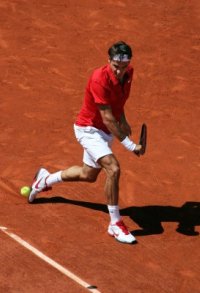|
The Federer Backhand: What We Can Learn From The Master

The backhand shot of Roger Federer has long been known as among the most beautiful and graceful strokes in the modern tennis game. The Federer backhand is a smooth and fluid shot which makes excellent results whenever he is in both defensive and offensive situations. With more and more players adopting the double-handed backhand, I think the Federer backhand is a masterpiece we should treasure. In this article, let us look at why his backhand is so superior and feared by his opponents. Federer's Preparation for the BackhandThe preparation for the backhand is considered to be an essential component of producing a successful shot. Federer’s preparation of his one-handed tennis backhand involved unitary body rotation. This is known as the Unit Turn. This unitary motion is one which permits the body to twist and coil as one unit, letting the body to fill up power onto the core muscles that is important in producing power.
Federer begins his backhand shot with the unitary twist of his body. Then, some solid take back is performed just after turning his body about 45 degrees. You will see that his racket is up, two hands are still on the racket and he is looking over his right shoulder. The moment Federer starts any actual backswing; his body has already turned sideways. Federer’s footwork in the court is considered one of the most efficient in the tour. Notice that when the ball comes to his backhand, he rapidly identifies it and immediately gets to the backhand grip. Federer makes a rapid rotation, turning the shoulders and hips with the turn. This rotation twists the body and then takes the racket up as the backswing. At this point of time, he is already in a balanced position ready to contact the ball. Federer's Contact PointOnce he gets in touch with the contact point, his arm is normally set straight at contact. Throughout the backswing and take back phase, his arm is normally bent a little, however, at contact point, he straightens it out greatly. His contact point is often within the front of his body. The concern about the position of the arm must occur naturally, only if the technique in the swing is properly done. Federer's Finish and Follow ThroughSometimes, you will see Federer raise the amount of rotation and topspin while executing the backhand. He is doing it for a greater margin of error as well as for safety. Then other times, he is able to make the one-handed backhand shot with aggression that causes his opponents to pull off the court. This won't be possible without the ability to produce the topspin backhand. After contacting the ball with great acceleration, the follow through phase is normally finished up higher. One good analogy is that his both hands spread like a pair of wings. His left foot also follow up for the recovery and he gets ready for the next shot. The whole stroke production of the Federer backhand is so beautiful and he made it seem so easy. The Federer backhand is one shot that any tennis player would love to have.
From "The Federer Backhand: What We Can Learn From The Master" To "How To Play Tennis Efficiently And Become A Better Player"
|
Do you want to get the exact step-by-step blueprint to look, feel, and perform better on the tennis court in only a few short weeks?
Pick up your copy of Show and Go today!
OncourtOffcourt.com for Tennis and Fitness Training Aids! Click here!
Get Access to the Best Tennis Serve Course







